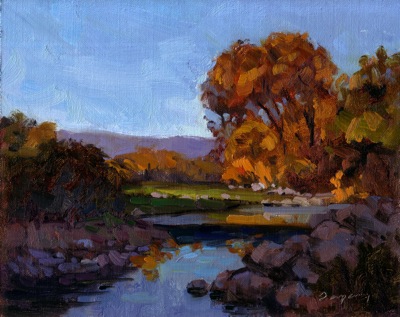The small town of Ojai is (pronounced /?o?ha?/) is a city in Ventura County, California. The city was founded as Nordhoff, until the time leading up to World War I, when anti-German sentiment was high. Ojai is a Chumash word meaning “Valley of the Moon”. It should be called “Valley of the Stars”, because Ojai is just close enough to Los Angeles (and beautiful enough) to attract lots of celebrity residents. Check out the list of “Noted Residents” in Wikipedia, which includes Anthony Hopkins, Jake Gyllenhaal, Johnny Cash, Tim Burton, and Howard Hughes, listed as an industrialist, who attended The Thacher School. In fact, just last week, this pic of Jake Gyllenhaal and Robert Downey Jr. was taken in the hiking trails around Ojai. But the only connection between Ojai’s celebrity and my painting is mentioned in the movie Thirteen, when Evie’s aunt declares that she and her niece are moving to Ojai so Evie “won’t get in any more trouble.” It is a place of quiet beauty.
This was painted in my studio from a reference photo, but luckily the scene was fresh in my mind as I did paint this riverbed study their “en plein air”. I did strugle somewhat with the large tree that stands as the center of interest. As I wrote about in my cloud studies post recently, I’m working on making every object three dimensional. I want the viewer to feel they could virtually walk around this tree, and know what the back side is like. What do you think? Any tips?
This reminds me of something Camille Przewodek said. She’s been focusing on the figure lately, and has been studying with the great master Jove Wang. Her figures had form, but they were not quite 3-dimensional. Jove taught her that when painting the figure, you need to indicate the complete form, even that not seen. When you paint a head, you need to show how the back of the head is formed. I have NO IDEA how to do this, but it’s just another reason why I need to study with Jove Wang someday.
Speaking of studying, I just signed up for a workshop with painter Kevin Weckbach at the Scottsdale Artists School in late February. I’ll try and blog it (with his permission). I really like the quality of abstraction and paint in his work (see galleries 1, 2, 3 and 4). I especially like these two: Glasses for Two and Red Spruce).


Beautiful painting! Love the way you brought a muted version of the tree color down into the foreground water.
On creating the illusion of three dimensions on a two dimensional surface, here’s a couple of things they taught us at the Academy of Art when I was in the illustration dept. there, FWIW:
My Illustration II teacher, Melinda Sullivan, blessings be upon her, told us to “acknowledge the third dimension”. I think that this is really a mental thing- what’s in your head while you do the drawing. We were to look for elements of the subject that provided opportunities to create that third dimension.
The dept. chair, Barbara Bradley, the toughest and one of the best teachers I ever had, said to think of drawing “around the form” as you do it, even saying it out loud if necessary- “Now I’m drawing AROUND the tree trunk/arm/apple, whatever, and lightly sketch in the contour lines if necessary to help see it. Keep in mind that the back of the trunk/arm/apple is there. For me, at least, that seems to help.
Also to think of the forms moving forward and back in space and using value and temperature to create that illusion. If a form is moving back in space, like the curve of a head, then there won’t be a hard line. So, a softer edge would create the suggestion that there is more “around the corner” so to speak, Ie: the back of the head.
Love to know if any of this makes sense. I deal with this issue all the time doing realistic animals from photo reference since I have to compensate for camera flattening/distortion.
Happy New Year!
Susan, this is very helpful. I believe the concepts you were taught about drawing the form, thinking of what’s behind and the 3rd dimension, sounds just what Jove Wang was explaining. I’ll have to try this.
Thanks for the response!
Ed, ooh i love those yellows and blues. masterful!! Holly
Lovely paintings as always, Ed! I studied with Jove Wang (after being encouraged by Camille) and I recall him talking about painting the atmosphere surrounding the form; and, as the above reader suggests, softening the lines to suggest that feeling of moving around the corner. And as you probably know, he emphasizes painting your feeling about your subject, focusing on the chi that captured your attention in the first place. He is a gracious and kind instructor.
I love Kevin Weckback’s work, can’t wait to hear about the workshop!
And I want to say, thanks so much for your kind comments about my work–I am SO honored.
Faye
P.S.–Johnny Cash won’t be found there; unfortunately he passed in 2003.